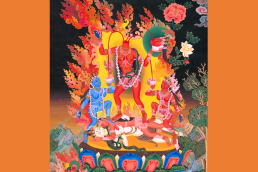I have been poring over tantric and Hindu texts for decades. In my view, key texts and key philosophical points in Dharmic philosophy point to the prime importance of non-orgasmic sex as a spiritual practice.
Therefore, it’s a source of recurring frustration to me when Western scholars insist on disregarding the implications of such texts in order to cram them, like square pegs into round holes, into preconceived assumptions. Perhaps the most rigid of these assumptions is that “using sex for lofty ends” must always refer to procreative sex!
I think this assumption is just plain incorrect. It’s the product of cultural prejudice or perhaps evolutionary myopia.
It has long been known in various cultures, both ancient and modern, that there is a way to redirect sexual energy for spiritual purposes, such as achieving higher states of consciousness and realizing the divine nature of the Self. But practitioners must learn sexual self-control to pursue this path, especially when engaged in sexual intercourse.
Bhagavad Gita
Consider the following from Chapter 7 of the Bhagavad Gita (“Song of God”) scripture:
Bhagavad Gita 7.9
I am the pure fragrance of the Earth, and the brilliance in fire. I am the life-force in all beings, and the penance of the ascetics.Bhagavad Gita 7.10
O Arjun, know that I am the eternal seed of all beings. I am the intellect of the intelligent, and the splendour of the glorious.Bhagavad Gita 7.11
O best of the Bharatas, in strong persons, I am their strength devoid of desire and passion. I am sexual activity not conflicting with virtue or scriptural injunctions.
For me, it’s evident that the Bhagavad Gita does not forbid sexual activity. It merely decrees that sex must not “contradict virtue” or “scriptural injunctions”. Many of the relevant scriptural injunctions appear to point away from satisfaction of desire.
Alas, scholars who are unaware of (or unenthused by) the practice of sex without climax, presume that lovers must have sex solely for procreation if they would be virtuous. These scholars seem oblivious to the alternative way of managing sexual energy taught to advanced disciples: intercourse with sexual continence, that is, intercourse without orgasm.
Some academics also seem intent on equating the meaning of “sexual bliss” with “orgasmic release”. Perhaps they are not aware that sexual bliss can be enjoyed without the need to experience the conventional end goal.
This is not a rash hypothesis on my part. In the same chapter of the Bhagavad Gita, just before the above verses, Krishna emphasises that these ideas have never been popular. “Amongst thousands of persons, hardly one strives for perfection; and amongst those who have achieved perfection, hardly one knows Me in truth.” Bhagavad Gita 7.3
Yet on our crowded planet is anything more popular, or even religious, than procreation? And surely nothing is more common than orgasm. Evidently the text is referring to a sexual path to perfection that is quite different from humankind’s default choice.
Sword’s edge
In my view, the Bhagavad Gita is referring to an approach to managing sexual desire similar to the ancient “sword’s edge” practice, the asidhārāvrata. Sword’s edge practitioners exposed themselves to sexual temptation without fully consummating the sexual act.
The “sword” served as a powerful metaphor for the self-discipline required to maintain this practise. It reminded spiritual seekers of the potential for both destruction and transformation in the realm of sexuality.
Conscious effort is required to escape the bondage of our senses and the impulses of our appetites. A determined disciple frees his mind from enslavement to desire during sex, magnifying the preserved power of Shakti (desire) combined with love. This generates immense physical, mental, and spiritual benefits.
Madeleine Biardeau states: “Liberation is achieved by harnessing desire (Kama) – in every sense of this word and in all its relative values – to the service of liberation.” (Hinduism, anthropology of a civilization, Flammarion, 1995.) Harnessing desire means not giving it free rein, not allowing our biological programming to rule us.
Descriptions of the asidhārāvrata in its various forms date back at least as far as the seventh-eighth centuries. In addition, a passage about celibate householders in the Vaikhānasagrḥyasūtra text suggests that the asidhārāvrata may date back at least to the fourth century. The Bhagavad Gita itself dates to the second half of the first millennium BCE.
In short, this concept of harnessing desire, rather than allowing our impulses to reign, has been around a long time. Maybe it’s not too much to hope that these ideas will one day be put forth as “definite possibilities” instead of being tossed aside by much of Academia.



